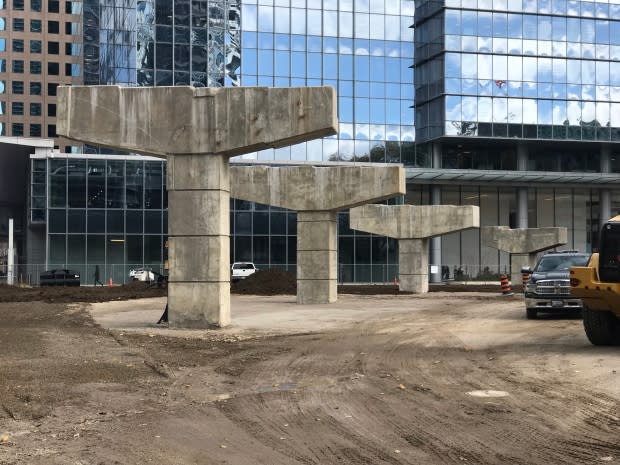Why this man is fighting to save old highway pillars, aka Toronto's 'modern Stonehenge'
Daniel Rotsztain is fighting to save support pillars that no longer have anything to support.
Nestled in a lot near Union Station and the shadow of the Gardiner Expressway, they're salt-stained and scarred leftovers from the demolition of the York Street highway ramp.
But to him, the pillars are beautiful, important, and worth preserving.
"It's like Toronto's modern Stonehenge," Rotsztain, a writer and cartographer, told CBC Toronto. "It's one of Toronto's best unintentional art projects."
The support pillars are currently slated to be razed when a new park is built next year in the space, which runs along York Street between Queens Quay West and Harbour Street.
Armed with an online petition, Rotsztain is hoping that Waterfront Toronto, the agency presiding over the transformation, will reconsider.
A point of connection to the past
"I see an opportunity to create a monument to how far we've come as a city, and our past," said Rotsztain, whose writing and illustration work is posted on his website, theurbangeographer.ca.
He believes that keeping the pillars will remind people of the area's industrial roots and the successful reclamation of public space.
"Taking down highways is still part of the public discourse," he said. "It's still an issue, as we saw in the last mayoral election."

In early October, Waterfront Toronto announced that Montreal firm Claude Cormier and Associates had won a design competition for the space.
Their design, featuring a pond ringed with trees as its focal point, was unanimously selected for its "simple and timeless nature," Waterfront Toronto wrote in a release at the time.

Claude Cormier and Associates are known for their work on other iconic Toronto spaces like Sugar Beach and the Berczy Park fountain.
'They have no aesthetic value'
In his admiration for the pillars, Rotsztain might be in the minority.
Ulla Colgrass, chair of the planning committee for the York Quay Neighbourhood Association, has been waiting for them to be gone since 2008, when her group started asking the city to take down the ramp.
"People who live here are very, very anxious to get those pillars down," she told CBC Toronto. "They have no aesthetic value and they have no historical value."
In response, Rotsztain said he thinks that historical value is subjective and that the pillars are a unique artifact of Toronto history.
As part of his pitch, he points to other successful uses of highway infrastructure in public space — most notably the Bentway, New York's Highline, and a series of pillars left standing on Lake Shore Boulevard East, where the easternmost section of the Gardiner Expressway was taken down at Leslie Street in the early 2000s.

"[They] are a mirror to Toronto's history and its design culture. We are a concrete city. We are a city full of big brutalist buildings and expressways," he said.
Major changes unlikely
In a statement, a spokesperson from Waterfront Toronto told CBC News that the park design selection process had included opportunities for the public to make its feelings known, including through online feedback and public consultation.
But Rotsztain writes in his petition that despite a public consultation and online survey during the selection process, "we believe that our desire to keep the pillars was not heard."
He plans to deliver the petition to the Waterfront Toronto executive team in the next few weeks.
Waterfront Toronto says while the winning design might be refined, it's unlikely that any major changes will be suggested, though another round of public consultation is coming in the spring.

Rotsztain said though he knows his bid might not be successful, he had to try.
"It's not the hill to die on, but I want to be active in the city I live in," he said.
"There's a risk when you create a blank slate out of a park and put something that could be anywhere."

